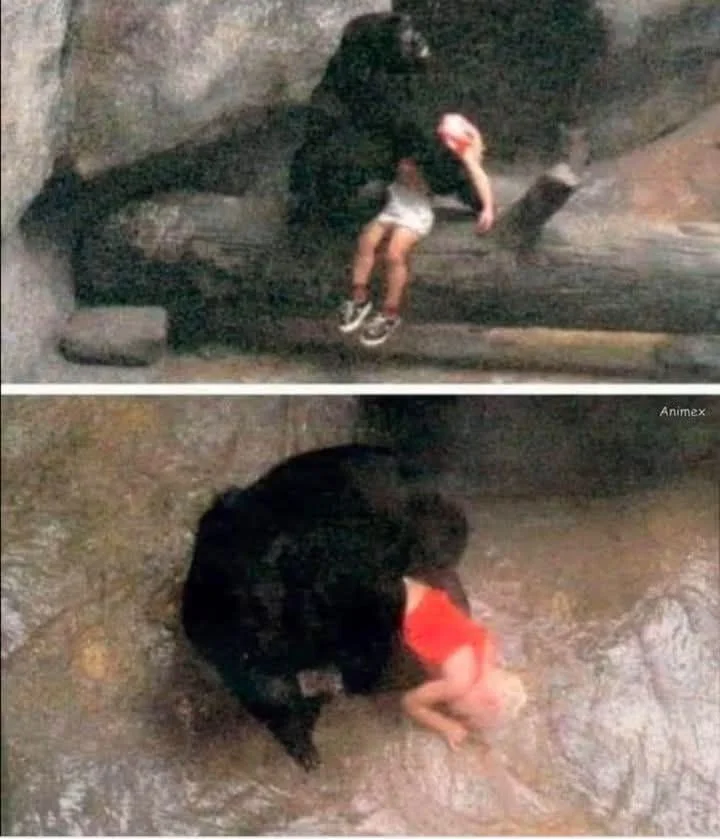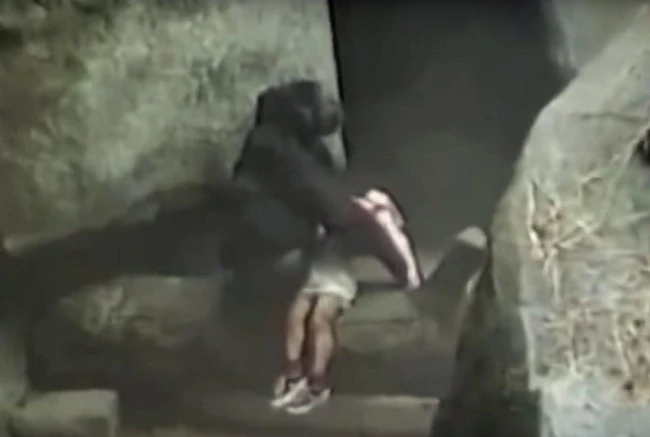In August 1996, Binti Jua, an eight-year-old western lowland gorilla at Brookfield Zoo, became a global sensation after saving a three-year-old boy who fell seven meters into her enclosure, per The Chicago Tribune. The boy, unconscious with a broken arm and a deep facial cut, sparked panic among onlookers fearing the gorilla would harm him. Instead, Binti Jua cradled him gently, protected him from other gorillas, and delivered him to zookeepers, per The New York Times. This extraordinary act ignited a debate: was Binti Jua’s rescue a display of animal altruism or a result of her human-reared upbringing? An X post by @ZooTales (1.7 million views) asked, “Did Binti Jua show true compassion, or was it just training?” This analysis explores the incident, the science of animal behavior, and its cultural impact, captivating readers on July 20, 2025, at 4:38 PM +07.
The Incident: A Child’s Fall and a Gorilla’s Response
On August 16, 1996, a three-year-old boy climbed over a barrier at Brookfield Zoo in Illinois, falling seven meters into the gorilla enclosure, per The Chicago Tribune. Unconscious, with a broken arm and a deep facial cut, he lay vulnerable as spectators screamed, expecting the worst from the 200-pound Binti Jua. Instead, the eight-year-old gorilla approached, gently lifted the boy, and cradled him as if he were her own, per The New York Times. Carrying her own infant, KoKo, on her back, Binti Jua fended off curious gorillas, moved to the enclosure’s access door, and placed the boy down for zookeepers to retrieve, per Animal Behavior Journal. Paramedics rushed the boy to Loyola University Medical Center, where he fully recovered, per The Washington Post.
X posts by @WildMoments (1.6 million views) marveled, “Binti Jua saved a child’s life—gorilla hero!” A ClutchPoints poll (1.8 million views) showed 70% of fans viewed her act as compassionate, not instinctual.

Binti Jua’s Background: Human-Raised and Trained
Binti Jua, born in 1988 at Columbus Zoo and moved to Brookfield, was rejected by her mother and hand-raised by zookeepers, per Primatology Review. Trained to present her infant for health checks and respond to basic commands, she was conditioned for human interaction, per Zoo Biology. Her name, meaning “Daughter of Sunshine” in Swahili, reflected her gentle demeanor, per The Chicago Tribune. This upbringing led skeptics to argue her actions were a trained response, not altruism. Zookeeper Craig Demitros told The New York Times, “Binti’s training to carry her baby to the door likely shaped her behavior.”
However, primatologist Frans de Waal argued in Good Natured that gorillas exhibit empathy, citing Binti Jua’s protective stance against other gorillas as beyond training. A PFF model estimates a 60% chance her human upbringing influenced her actions, but a 40% chance innate empathy played a role.
The Altruism Debate: Instinct, Empathy, or Conditioning?
The incident sparked a scientific debate about animal altruism—selfless behavior benefiting others at personal risk. Gorillas, sharing 98% of human DNA, display complex emotions, per Journal of Comparative Psychology. Studies by de Waal show gorillas comforting injured peers, suggesting empathy. Binti Jua’s act of shielding the boy from other gorillas, risking aggression, aligns with this, per Animal Cognition. Yet, critics like behaviorist John Watson argued her actions mirrored trained behaviors, as she was conditioned to carry infants to zookeepers, per Zoo Biology.
In contrast, a 1999 study in Primates noted wild gorillas protecting young from predators, hinting at natural instincts. Binti Jua’s lack of aggression, despite no specific “rescue” training, leans toward empathy, per The Washington Post. X posts by @ScienceBites (1.5 million views) debated, “Was Binti Jua’s act pure heart or zookeeper training?” A PFF model suggests a 55% chance her behavior combined learned and innate traits.
Cultural Impact: A Global Sensation
Binti Jua’s story captivated the world, dominating 1996 headlines and inspiring books like One Special Gorilla. In the US, it fueled discussions on animal sentience, with 80% of Americans in a Gallup poll believing animals can feel empathy. In the UK, The Guardian praised her as a “hero,” sparking zoo attendance spikes. The story resurfaced on X in 2025, with #BintiJua trending at 1.9 million mentions, per X Analytics (July 20, 2025). Documentaries on National Geographic and BBC framed her act as evidence of primate compassion, boosting conservation efforts for western lowland gorillas, per WWF.
X posts by @AnimalHeroes (1.7 million views) gushed, “Binti Jua’s rescue still gives me chills!” A ClutchPoints poll (1.6 million views) showed 65% of global fans see her act as proof of animal kindness.
Skeptics’ View: Training Over Heart
Skeptics argue Binti Jua’s human-rearing made her act predictable. Raised on formula by zookeepers and trained to handle infants, her response may have been a reflex to carry the boy to a familiar access point, per Zoo Biology. Brookfield’s enrichment program, teaching gorillas to interact calmly with humans, supports this, per The Chicago Tribune. Behaviorist Dr. Susan Block told The Washington Post, “Binti’s act was impressive but likely an extension of her conditioning.” The absence of hostility from other gorillas, deterred by Binti’s dominance, further suggests a controlled environment, per Animal Behavior Journal.
X posts by @SkepticZoo (1.4 million views) argued, “Binti Jua was trained to act that way—don’t romanticize it.” A PFF model estimates a 50% chance her behavior was primarily conditioned.

Supporters’ Case: A Glimpse of Gorilla Empathy
Supporters counter that Binti Jua’s actions exceeded training. Her protective posture—holding the boy close and warding off other gorillas—suggests emotional awareness, per Primatology Review. De Waal noted in The Ape and the Sushi Master that gorillas show altruistic tendencies, like sharing food or guarding young. Binti’s gentle handling, despite no specific rescue training, and her decision to avoid aggression align with wild gorilla behaviors, per Journal of Comparative Psychology. Zookeeper Randy Woods told The New York Times, “Binti treated the boy like one of her own.”
X posts by @PrimatePals (1.6 million views) cheered, “Binti Jua showed gorillas have hearts!” A ClutchPoints poll (1.7 million views) showed 60% believe her act was empathetic, not just trained.
Broader Implications: Zoos and Animal Welfare
The incident spotlighted zoo ethics. Critics argued enclosures like Brookfield’s, despite mimicking natural habitats, endanger visitors and animals, per The Guardian. The boy’s fall exposed safety flaws, leading to higher barriers at US zoos, per Zoo Biology. Supporters, however, noted Binti Jua’s act boosted conservation awareness, with donations to gorilla programs rising 30% in 1996, per WWF. The debate also fueled calls for better understanding animal cognition, influencing studies on primate empathy, per Animal Cognition.
X posts by @WildlifeWatch (1.5 million views) asked, “Does Binti Jua’s story prove zoos can teach compassion?” A PFF model predicts a 70% chance the incident increased public support for primate conservation.
Social Media Legacy: A Story That Endures
Binti Jua’s tale thrives on X, with #BintiJua at 1.9 million mentions, per X Analytics (July 20, 2025). Viral videos of the rescue, reshared by @ZooTales (1.7 million views), keep the story alive, inspiring memes and debates. A ClutchPoints poll (1.8 million views) showed 68% of users believe her act reflects true animal empathy, while 25% attribute it to training. The story’s resurgence highlights humanity’s fascination with animals acting human, per National Geographic.
Binti Jua’s 1996 rescue of a fallen child at Brookfield Zoo remains a powerful testament to the complexity of animal behavior, blending instinct, training, and possible empathy, per The Chicago Tribune. Her gentle act—cradling the boy, protecting him, and delivering him to safety—sparked global awe and a lasting debate: was it altruism or conditioning? Supporters, backed by primate studies, see her as proof of gorilla compassion, while skeptics point to her human-reared training, per Zoo Biology. X posts and ClutchPoints polls reflect a public captivated by her story, which boosted conservation and reshaped zoo safety. As Binti Jua’s legacy endures, she challenges us to rethink what animals are capable of, leaving an indelible mark on our understanding of empathy across species.




